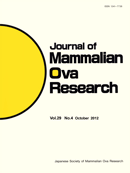30 巻, 3 号
選択された号の論文の7件中1~7を表示しています
- |<
- <
- 1
- >
- >|
Mini Symposium
-
2013 年 30 巻 3 号 p. 67
発行日: 2013年
公開日: 2013/12/05
PDF形式でダウンロード (275K) -
2013 年 30 巻 3 号 p. 68-78
発行日: 2013年
公開日: 2013/12/05
PDF形式でダウンロード (701K) -
2013 年 30 巻 3 号 p. 79-85
発行日: 2013年
公開日: 2013/12/05
PDF形式でダウンロード (1217K) -
2013 年 30 巻 3 号 p. 86-94
発行日: 2013年
公開日: 2013/12/05
PDF形式でダウンロード (972K) -
2013 年 30 巻 3 号 p. 95-100
発行日: 2013年
公開日: 2013/12/05
PDF形式でダウンロード (1036K)
Review
-
2013 年 30 巻 3 号 p. 101-108
発行日: 2013年
公開日: 2013/12/05
PDF形式でダウンロード (491K)
Original
-
2013 年 30 巻 3 号 p. 109-116
発行日: 2013年
公開日: 2013/12/05
PDF形式でダウンロード (844K)
- |<
- <
- 1
- >
- >|
